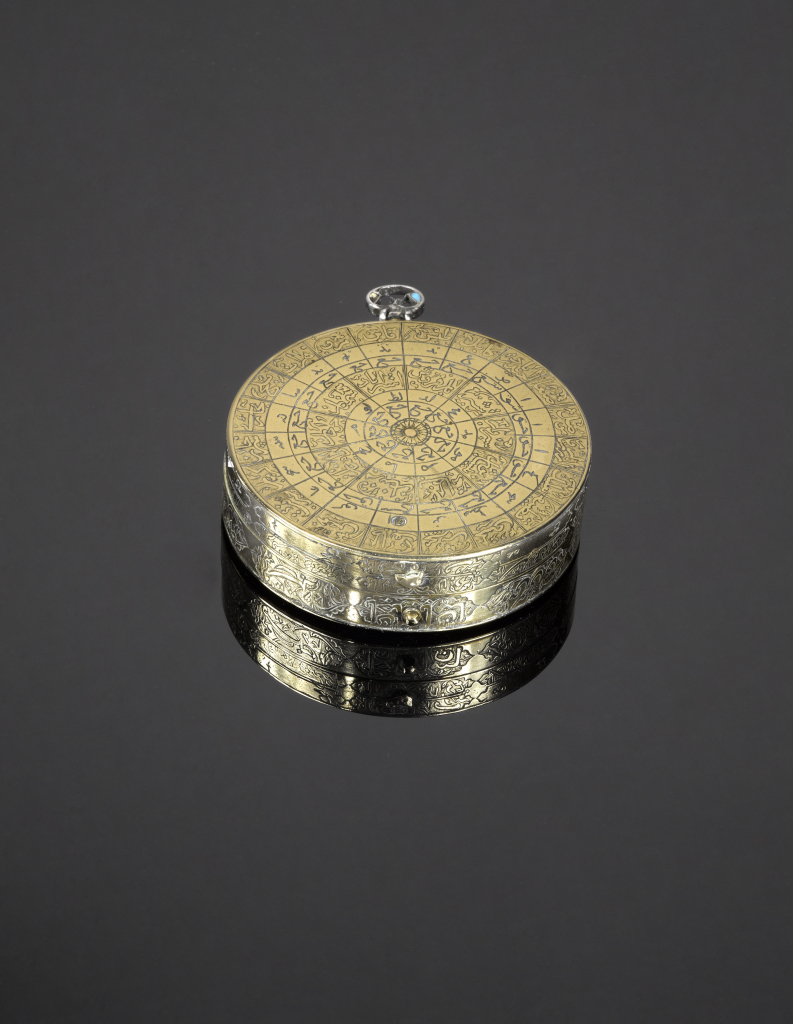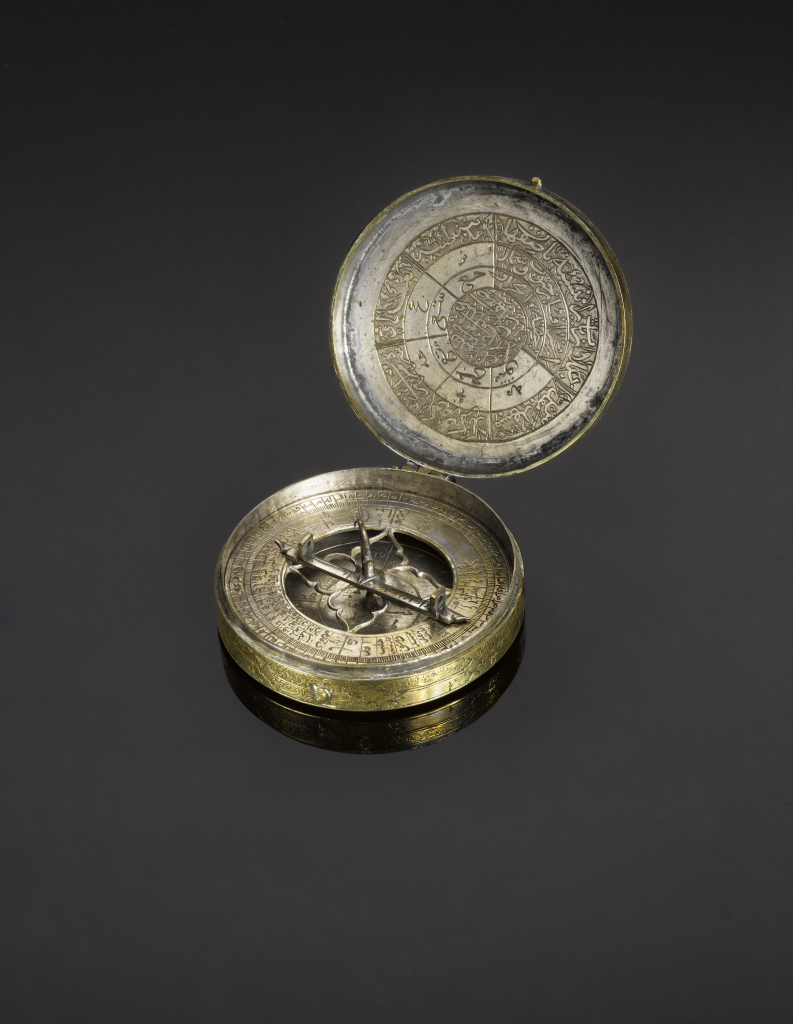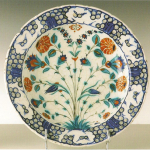Qibla-indicator by the celebrated instrument-maker of late Safavid Isfahan, ‘Abd al-‘Alî, dated 1703-04
Brass and silver-inlaid brass, engraved. With a turquoise stone on the silver clasp (Lacks the compass needle and its glass cover)
Safavid Persia, Isfahan, dated A.H. 1115/1703-04
Diameter: 5.9 cm. Height: 1.7 cm
Interest in the qibla (the local direction of Mecca) was particularly great in Timurid and Safavid Iran. A monumental table was compiled in the mid 15th century in Kish near Samarqand: this contained the longitudes and latitudes of 274 localities from al-Andalus to China, together with the qibla and distance to Mecca for each one, mainly accurate to the nearest minute of arc. Extracts from this table and simplified versions of the data in it appeared in gazetteers on astrolabes and on qibla-indicators, that is, pocket-sized compass-boxes engraved with the qiblas of important cities in Greater Iran. Hundreds of Safavid and Qajar qibla-boxes survive but most are anonymous.
This qibla-indicator is signed by ‘Abd al-‘Alî, one of the leading instrument-makers of late Safavid Isfahan. He is known by at least seven astrolabes, of which one – the only one that has been published – was dedicated to Shah Husayn II in 1124 Hijra/A.D.1712. That particular astrolabe is a masterpiece of technical and artistic skill. He always signs himself aqall al-talaba, “the least of students”, possibly indicating his feeling of indebtedness to the (two) previous generations of Isfahan instrument-makers. Their instruments are usually engraved in a mixture of Arabic and Persian, often with a distinctly Shi’ite flavour, and they also combine varieties of naskhî and thuluth script.
All numbers are given in the standard Arabic alphanumerical (abjad) script.
Our maker’s signature is at the centre of the top of the lid in Arabic: “Made by the least of students ‘Abd al-‘Alî al-Isfahânî in the year ??”. At first sight the date reads 1150 Hijra, but the final dot for the zero may not be part of the date. This would mean that we should read 115 and that the date is [1]115, that is, A.D.1703-04., which corresponds better to the year-numbers [1]119, 1124, 1126 of the three astrolabes of his that are dated.
The Persian inscription in cartouches around the rim of the box is unusual in that it appears to offer respects to an anonymous user:
“O The Most Compassionate! (yâ hannân), O The Propitious! (yâ mannân), O your honour (janâb), the one with a pure face, if you want to find the qibla accurately from your own locality, then (the instrument should be turned so that) the bird (of the compass) points due south (on the horizontal scale) and the (value) engraved (on the appropriate part of the box) will show you the qibla for your locality.”
The compass that was originally embedded in the box would have been in the form of a blue bird facing south. On the annulus with an internal quatrefoil frame that would have fitted over the original glass cover (to protect the compass), the qibla directions of some 40 localities, mainly in Greater Iran, are indicated. The qibla is called inhirâf, that is, literally, “deviation”, and this is measured north or south from the meridian; the associated quadrant is called “jiha”, the “direction” being abbreviated in a standard form, such as j-gh for janûbî-gharbî, “south-west”, and sh-q for shamâlî-sharqî, “north-east”.
On the top and bottom of the box the qiblas of some 69 localities are given to the nearest degree. Most of these are in south-west quadrant. Some additional values are given in cartouches around the rim. Examples are Baghdad 13° SW, Alamut 29° SW and Shiraz 53° SW.
On the inside of the lid are the names of six other Shi’ite pilgrimage sites (bilâd-i ziyârât), namely, Medina, Baghdad, Samarra, Kufa and Kerbela, and Meshed, with their directions from Isfahan, such as are found on a minority of other qibla-boxes.
Inside the bottom there are engraved ordered triads of numbers from (1,11,21) to (10,20,30) in Hindu-Arabic notation. Although these are systematically arranged according to the cardinal directions, they have nothing to do with qibla determinations and their presence here is a mystery. The word(s) at the centre is/are alas unintelligible.
The alidade is from a (very small) Iranian astrolabe and has no place on this instrument.
Bibliographical notes
On medieval Islamic instrumentation see King 2004-05, vol. 2 On medieval qibla-determinations, Safavid interest in the qibla, the Kish table, Safavid gazetteers, and directions from Isfahan to various Shi’ite pilgrimage sites, see King 1999 and King 2004-05, vol. 1, part VII. On ‘Abd al-‘Alî and his astrolabes see Mayer 1956, pp. 27-28. On his astrolabe for Shah Husayn II see the splendid 1856 study by Morley, reprinted as the introduction to Gunther, Astrolabes of the World, vol. 1.
I am very grateful to Prof. David King for his description of this instrument, and Manijeh Bayani for reading the Persian inscription around the rim.






